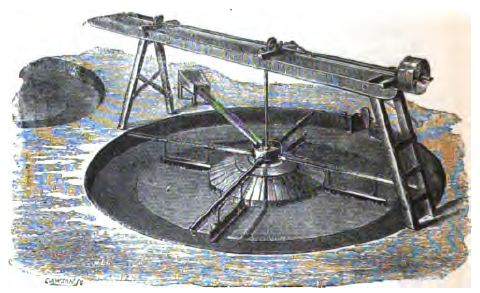Buddle Pit on:
[Wikipedia]
[Google]
[Amazon]


 A buddle pit or buddle pond is an ore processing technique that separates heavier minerals from lighter minerals when the crushed
A buddle pit or buddle pond is an ore processing technique that separates heavier minerals from lighter minerals when the crushed

ore
Ore is natural rock or sediment that contains one or more valuable minerals, typically including metals, concentrated above background levels, and that is economically viable to mine and process. The grade of ore refers to the concentration ...
is washed in water. This technique was used in the mining industry to extract metals such as tin
Tin is a chemical element; it has symbol Sn () and atomic number 50. A silvery-colored metal, tin is soft enough to be cut with little force, and a bar of tin can be bent by hand with little effort. When bent, a bar of tin makes a sound, the ...
, lead
Lead () is a chemical element; it has Chemical symbol, symbol Pb (from Latin ) and atomic number 82. It is a Heavy metal (elements), heavy metal that is density, denser than most common materials. Lead is Mohs scale, soft and Ductility, malleabl ...
and zinc
Zinc is a chemical element; it has symbol Zn and atomic number 30. It is a slightly brittle metal at room temperature and has a shiny-greyish appearance when oxidation is removed. It is the first element in group 12 (IIB) of the periodic tabl ...
. Many buddles seen today date from the Victorian era
In the history of the United Kingdom and the British Empire, the Victorian era was the reign of Queen Victoria, from 20 June 1837 until her death on 22 January 1901. Slightly different definitions are sometimes used. The era followed the ...
and are often circularly shaped. There was also a variation called the concave buddle, which had a concave bottom.
The pit, often constructed from stone, cement, or brick and mortar, contained water and used a set of brushes often powered by a water wheel
A water wheel is a machine for converting the kinetic energy of flowing or falling water into useful forms of power, often in a watermill. A water wheel consists of a large wheel (usually constructed from wood or metal), with numerous b ...
which rotated in the water in order to agitate the mixture. The result of which was that the heavier and denser material - i.e. the ore - tended to collect at the centre of the pit, from where it could be retrieved. The byproduct
A by-product or byproduct is a secondary product derived from a production process, manufacturing process or chemical reaction; it is not the primary product or service being produced.
A by-product can be useful and marketable or it can be cons ...
was then drained off and disposed of.
Usually a set of buddle pits were used to further refine the ore, where the processed ore was put in another buddle until the achieved concentration of the desired mineral was met.''Mining and mining machinery: explaining the methods of obtaining minerals, precious stones, &c., in all parts of the world'', by Sydney Ferris Walker, 1913
The following detailed extract comes from ''Machinery for Metalliferous Mines: A practical treatise for mining engineers, metallurgists and managers of mines'', by E. Henry Davies, C. Lockwood and son, 1902 :
See also
* Buddle pits in Dartmoor *Metal mining
Mining is the extraction of valuable geological materials and minerals from the surface of the Earth. Mining is required to obtain most materials that cannot be grown through agricultural processes, or feasibly created artificially in a la ...
* Metal mining in Wales
Mining in Wales provided a significant source of income to the economy of Wales throughout the nineteenth century and early to mid twentieth century. It was key to the Industrial Revolution in Wales, and to the whole of Great Britain.
Wales was f ...
* Adelong Falls Gold Workings (Australia)
References
{{Extractive metallurgy Mining techniques History of mining